The Morondava Baobabs
Three species of baobab are found in the dry forest north of Morandava on the west coast of Madagascar. We entered this area from the north, having taken pirogue (dug-out canoe) down the Tsiribihinia River from Mirandrivazo. On the third day on the river we entered baobab country. The locals call this tree ‘za’ and it was given the scientific name Adansonia za. What a change! To be using an indigenous name rather than the name of some foreign botanist. The tree stands tall above all of the other forest vegetation, though this is probably because the indigenous forest has been so degraded by years of slash and burn agriculture along the river, a major transportation route. The agriculturalists appear to leave the large baobabs alone. They are a lot of work to cut and the wood is soft and spongy so of no value for timber or charcoal. Their thick bark also appears to resist fire well. I presume that these conditions would not be conducive to regeneration, however. There are no young baobabs evident.
After coming off the river we spent a night at a ‘hotel’ of little thatched bungalows in the town of Antsiraraka. The town is on a baobab strewn hill surrounded by rice paddies. The hotel bar is built around the base of a baobab which was in full bloom every night. Beautiful yellow sweet smelling flowers which fell off in the morning, providing enticing munchies for the foraging goats. These gorgeous one night wonders are probably pollinated by long-tongued hawk moths, though I was not able to see any activity by moonlight. The fallen flower consists of a 8 to 9 cm staminal tube with about 100 attached anthers and the curled back sepals. There was often still copious sweet nectar at the base. The Madagascar baobabs are divided into two groups, longitubae and brevitube, based on the length of the staminal tube. A. za is clearly a longitubae. Perhaps an example of punctuated equilibrium (more on the theory later).
The next baobab we encountered was Adansonia grandidieri, named after a French botanist who documented a lot of the flora of Madagascar. The locals call it reniala or renala. It is a brevitubae with flowers that look like a shaving brush with many hundreds (a thousand?) of stamens. It is apparently visited by many mammals (including lemurs and bats) as well as insects such as moths and bees. Research is underway to identify which of these visits actually result in pollination. Graduate students climb the trees during flowering and spend the night watching the nocturnal visitors. This is the remarkable tall baobab of the ‘Avenue des Baobab’ and the tourism pamphlets of Madagascar. It’s fruit is for sale in the market and along the roadside.
Growing very much in the same area as the reniala is the ‘fony’, known scientifically as Adansonia rubrostipa, another longitubae species, but finished flowering recently. We were fortunate to make contact with Sehenu, a graduate student studying the dispersal of baobabs who took us into a protected forest study area where we saw all ages of this species, including lots of promising regeneration. The question of seed dispersal in Malagache baobabs has long been an area for botanical/ecological speculation since there appear to be no animals (other than recently arrived humans) large enough to carry the fruit. Sehenu is trying to get some facts. Imagine feeding baobab fruit to a giant tourtoise and then checking the scat daily for two weeks until the seeds finally came out the other end. Then collecting the seeds and planting them to see if they germinate. Lots of other animals get fed baobab fruit by Sehenu. But perhaps the fruit doesn’t have to be carried anywhere. If they break open and the seeds are consumed by smaller animals, dispersal could happen.
All three species were fully leafed out in a forest of leafless trees.The dearth period in the tropics is often the dry season, when plants lose their leaves so as not to suffer water deficit. Winter of the tropics, so to speak. The rains are late this year and the forest is a very hot, dry place to be. The baobabs, however, leaf out in anticipation of the coming rains – a head start start using water stored in the enormous spongy trunk.
Next stop, the northern baobabs.
Adansonia za flower
Adansonia grandidieri at ‘Allee des Baobab’ (no forest left)
Adansonia rubrostipa in natural forest (dry season)
Natural regeneration of A. rubrostipa
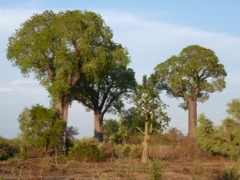
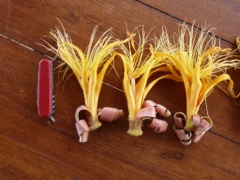
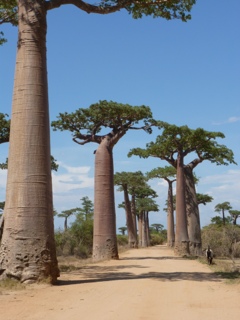
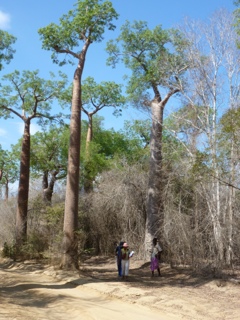
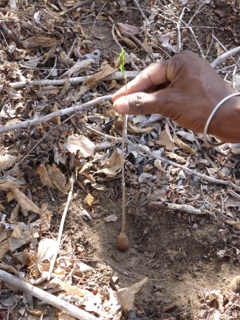
Leave a Reply